BMW’s all-new version of its 10-year old S 1000 RR superbike model is here, and we went to Portugal and the Estoril racetrack to ride it. Read below for our 2019 BMW S 1000 RR First Review.
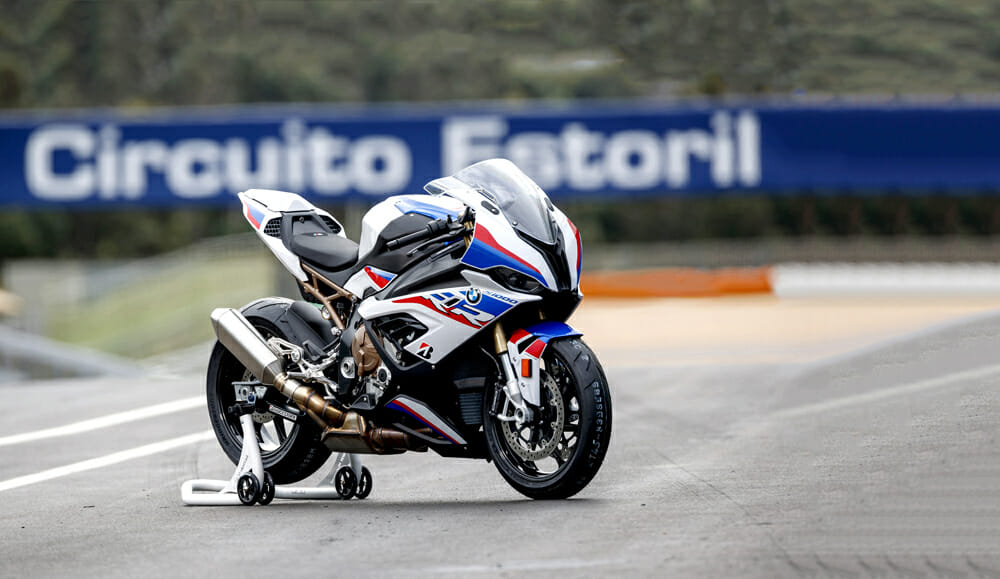
Ten years on since BMW’s original game-changing ultra short-stroke S 1000 RR set new standards for series production transverse in-line four-cylinder superbike technology with its 2009 debut, the all-new 2019 model launched at the EICMA Milan Show last November is equally innovative, but in a more subtle way. Call it evolution, not revolution.
Deliveries won’t, however, commence until June at a price of approximately $20,000, rising to roughly $25,000 for the top level M Package version, with a preset target for BMW of 6000 bikes to be produced this year in its Berlin factory, for which there’s already a long waiting list despite their late arrival in the marketplace.
However, there was nothing very subtle about the targets which the German company’s top management set its engineers when they began work in 2015 on developing what amounts to an all-new bike, with less than 5% of the 8200 components making up the entire motorcycle, including the engine, carried over from before.
“Our brief to them was to take the previous model, which has been such a dominant force in competition for the past 10 years, and significantly improve on its performance,” says BMW Motorrad President/CEO Dr.Markus Schramm. “To achieve this, we set ourselves some very straightforward targets. We wanted the bike to be one second faster on the racetrack, more than 22 pounds lighter, and easier to control with improved rideability. These targets formed the basis for every technical decision [made] in developing the new model, and the result is a motorcycle which exceeds the targets we set ourselves, and will once again be the category benchmark.”
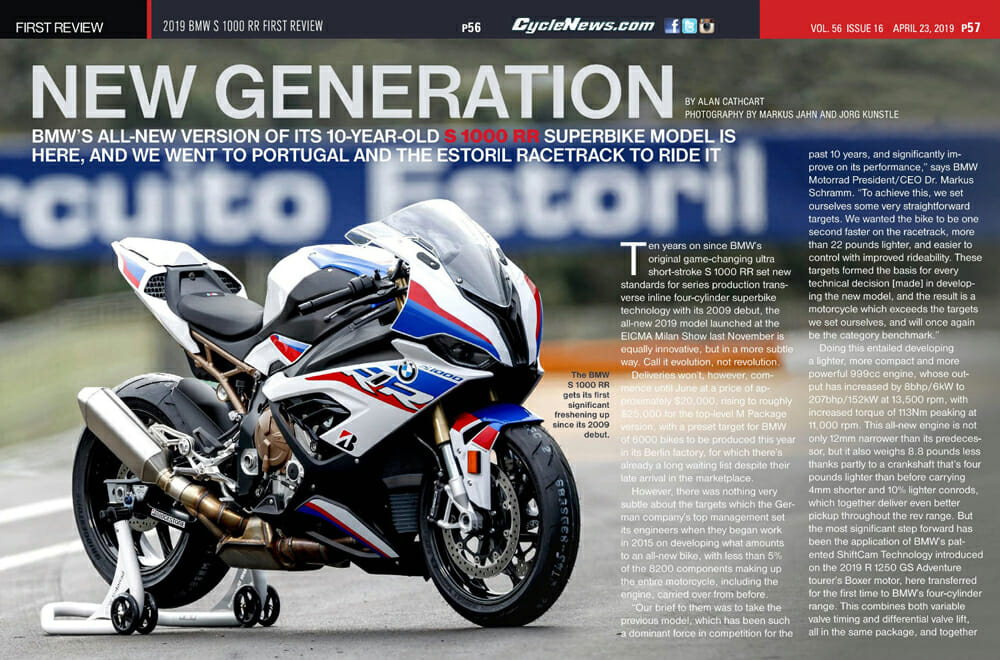
By Alan Cathcart
PHOTOGRAPHY BY MARKUS JAHN AND JORG KUNSTLE
Click here to read the 2019 BMW S 1000 RR First Review in the Cycle News Digital Edition Magazine.
Doing this entailed developing a lighter, more compact and more powerful 999cc engine, whose output has increased by 8bhp/6kW to 207bhp/152kW at 13,500 rpm, with increased torque of 113Nm peaking at 11,000 rpm. This all-new engine is not only 12mm narrower than its predecessor, but it also weighs 8.8 pounds less thanks partly to a crankshaft that’s four pounds lighter than before carrying 4mm shorter and 10% lighter conrods, which together deliver even better pickup throughout the rev range. But the most significant step forward has been the application of BMW’s patented ShiftCam Technology introduced on the 2019 R1250GS Adventure tourer’s Boxer motor, here transferred for the first time to BMW’s four-cylinder range. This combines both variable valve timing and differential valve lift, all in the same package, and together with revised cam profiles and altered valve timing, is responsible for at least 100Nm of torque being available between 5500 rpm and the short-stroke engine’s 14,600 rpm limiter. And that eight pounds of weight saving comes despite the 2.2 pounds extra weight entailed in fitting the ShiftCam system.
2019 BMW S 1000 RR Engine and Exhaust

Also, to further reduce reciprocating weight the S 1000 RR engine now employs titanium 33.5mm inlet valves, while retaining steel for the 27.2mm exhausts. Already weighing roughly half the amount of steel ones, in a world first for series production motorcycles the shafts of the titanium inlet valves are hollow-bored to reduce weight by another 10% further. This Formula 1-derived technology is matched by F1-type DLC-coated rocker arms which as before operate the valves, but these are now smaller and thus 25% lighter than in the previous motor, allowing the engine speed to be increased safely by 400 revs to 14,600 rpm, with a commensurate rise in peak power while running a 13.3:1 compression ratio. And the offset chain drive to the twin overhead camshafts is now driven directly off the crank: the previous idler gear is no longer needed.
Revised porting for the 16-valve DOHC engine’s inlet ducts, coupled with a new stainless steel exhaust system that’s 1.3kg lighter with twin three-way catalysts, dual lambda sensors before and after the catalyst, and an electronic power valve, all contribute to the new bike’s increased overall performance even in Euro 4 compliant street-legal guise. And as before, the new RR engine is also fitted with a variable-length intake system whereby the length of the inlet funnels atop the 48mm throttle bodies is shortened via an electric motor at 9500 rpm to enhance top end performance in conjunction with the ShiftCam Technology system. Moreover, the throttle linkage operating the four butterflies is split into two, with the two left-hand throttle bodies operated separately than the two right-hand ones. This allows BMW race teams to program the two pairs to work independently at lower rpm to give the same benefits as a twin-cylinder motor in terms of traction and drive exciting a turn, before all four resume working in unison at higher revs.

This feature results from BMW deciding not to produce a big-bang Yamaha R1-type cross-plane-crank motor, but instead to employ its decade-long experience of a more traditional 180º ‘screamer’ motor in building a better such design. “We did consider a big-bang design at the very outset,” says S 1000 RR project engineer Michael Thewke, who’s anchored the whole project every step of the way over the past four years of development, “and we also briefly considered building a V4. But we decided against both of these early on, not only because we didn’t want to be seen to copy anyone else, but also because we had so much experience especially from Superbike and Endurance racing in developing the more traditional-type four-cylinder in-line engine, so we decided to concentrate on building an even better one!”
The resultant all-new motor powers what’s now a much lighter bike weighing 434.3 pounds with all liquids and a full 4.4-gallon fuel tank, against the outgoing model’s 458.6 pounds – so 24.3 pounds lighter than before, with a 53.8/46.2% frontal weight bias, compared to the older model’s 52.3/47.7%, thus delivering improved front end grip. And the M-Package version of the new bike resplendent in BMW’s trademark Motorsport color scheme scales even less at 425.5 pounds complete with carbon wheels as standard, plus a lightweight lithium-ion battery, sports seat and M-series chassis kit with an adjustable swingarm pivot and variable rear ride height. Racing Red is the only color the standard 2019 S 1000 RR comes in, though, which seems a little strange.
Riding the 2019 BMW S 1000 RR at Estoril
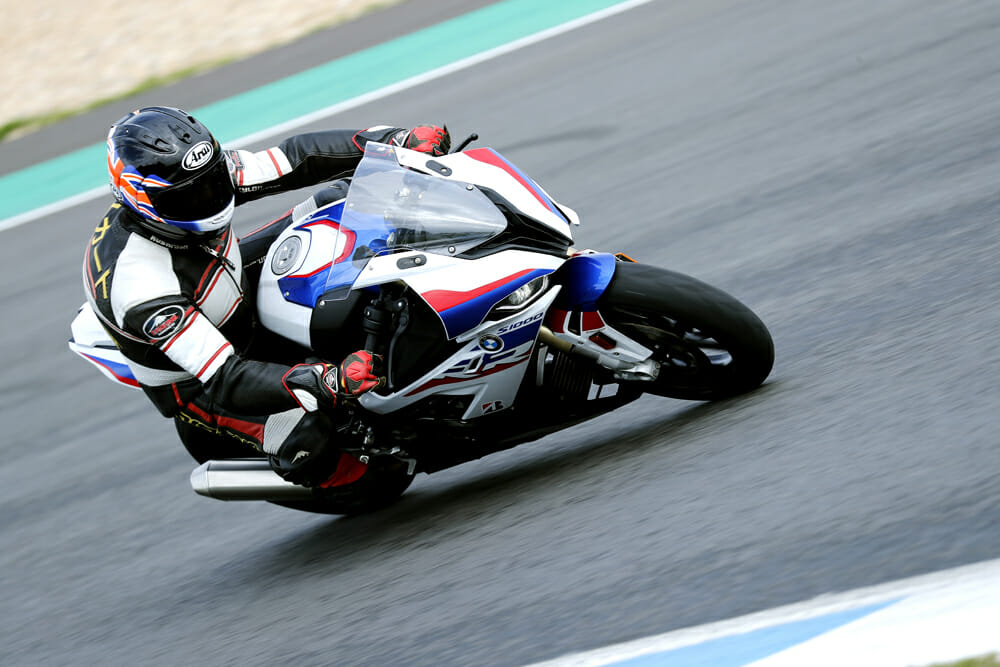
But it was an array of the M-bikes which awaited our group for the March press launch at the freshly resurfaced 2.6-mile Estoril GP track outside Lisbon—an event I’d been eagerly awaiting especially after riding the fabulous carbon-framed BMW HP4 Race version of the previous S 1000 RR there two years ago. But one reason there are so many golf courses in Portugal is that it rains there so much except in summer, and sure enough our early spring day there proved to be a washout, with damp patches on the hard-to-read new tarmac compromising my first 20-minute session on treaded Bridgestones, before increasingly heavy rain then set in. This deprived us of learning much about the bike, beyond how effective the Rain version is of the four RBW digital riding modes included in the new BMW’s Bosch ECU. Still, the weather meant Dr. Schramm could experience rain tires for the first time ever in a lifetime of motorcycling – kudos to the new (since April 2018) boss of BMW Motorrad for donning his wet suit and splashing around with the rest of us, then becoming all excited about getting his knee down in the rain for the first time!
2019 BMW S 1000 RR Suspension and Brakes
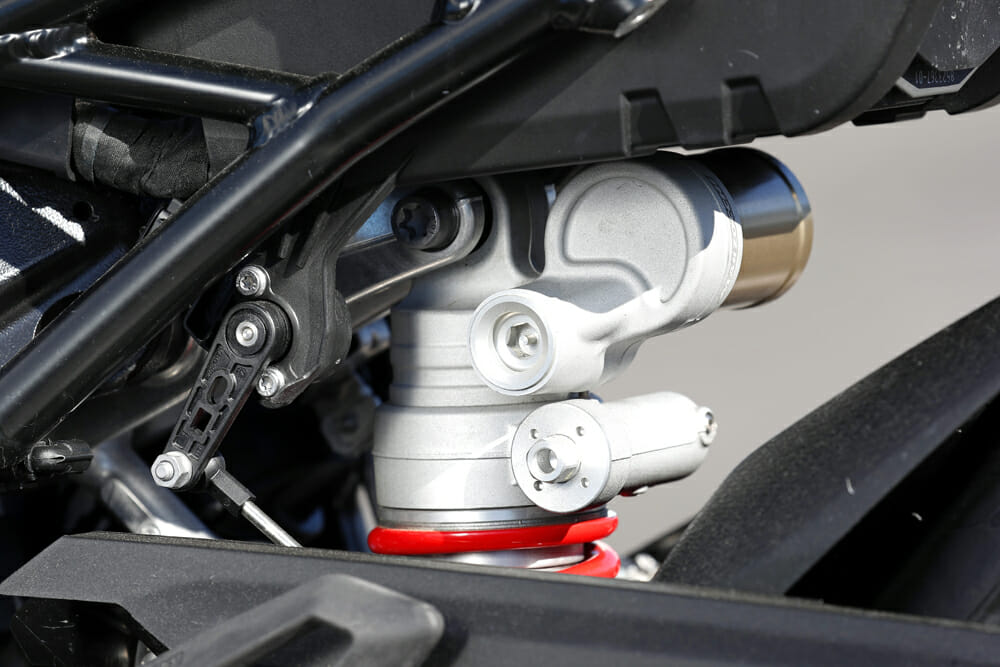
But in truth, the rain was doubly frustrating, because it prevented me experiencing the full benefits of BMW’s equally radical chassis development on the new model, whose most outward change is the dismissal of the old S 1000 RR’s trademark asymmetric headlights, while still retaining its recognizable silhouette fitted with a full range of LED lighting equipment. But beneath that the all-new 2.7-pound lighter twin-spar frame made from four cast aluminum sections welded together uses the engine as a fully-stressed member, with its cylinders inclined forward by 32º. However, in pursuit of excellence in this no-compromises machine, BMW has been ruthless in changing suppliers for its chassis hardware. Marzocchi replaces Öhlins as its suspension partner. Continental chosen instead of Bosch as its ABS supplier, and perhaps most surprising of all, American brake specialist Hayes supplanting Brembo to provide the rigidly-mounted four-piston radial brake calipers gripping the new S 1000 RR’s floating 320mm discs via a radial Nissin master cylinder. These discs are, however, still made by Brembo, ditto the 220mm rear disc and its single-piston caliper.
“We wanted to have a really small and also light ABS system, and Continental has a much smaller control unit weighing just 2.4 pounds, which meant we could package it better,” says Michael Thewke. “Moreover, they were prepared to work with us in developing the system, and that’s the reason we chose Marzocchi as our electronic suspension partner, too. Marzocchi was able to bring new technology with a completely different damping system which is working faster than its rivals. We worked very closely together throughout the development, and it was a win-win for both sides—they also learned a lot from us because we have great experience in manufacturing, also for the damping system. And it’s the same story with Hayes because we developed the new brake caliper completely together, not just took something from the shelf. Of course, we tested the performance of this brake, and it’s the same level as the Brembo one.”
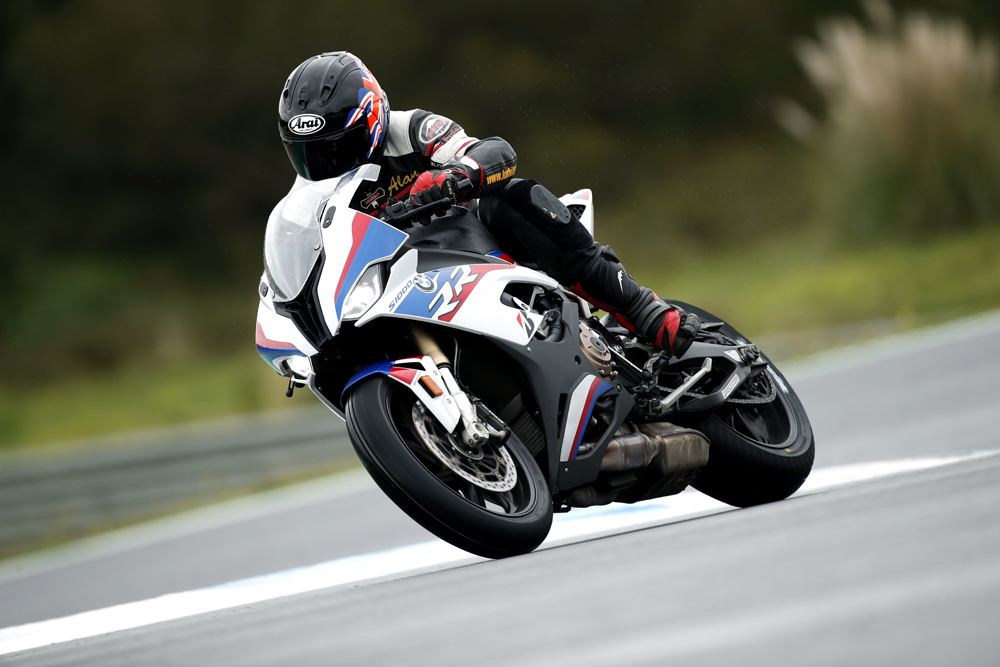
Sadly, I wasn’t able to try that out for myself properly beyond discovering that the U.S. brakes don’t have too fierce an initial bite, which might have proved how well the Continental ABS worked. Still, I found that out later. But I could certainly feel the benefits of the new S 1000 RR chassis design, which as soon as you sit on the bike you realize is much narrower across the frame behind the fuel tank. Even though the 32.4-inch seat height is actually slightly higher than the old model’s 32 inches, it feels lower thanks also to the fact that the fuel tank made from three aluminum sections is noticeably narrower at the rear where it meets the seat. This makes you feel much more as if you’re sitting in the new bike, rather than perched on top of it, which was always the case with the old one. The new chassis reduces the width of the BMW by .5 inches to 1.2 inches between your upper legs, so as a result, it was possible to make the new RR only about .8 inches wider there than a V4 motorcycle of equal capacity, says Michael Thewke.
The new bike’s handlebar position is a little different, too. It is wider, and the semi-clip-ons themselves are slightly dropped compared to before. However, the rider does sit in the same place relative to the axles, says Thewke. It is within the .3 inches longer 56.7-inch wheelbase. But there doesn’t feel to be as much weight on your wrists and shoulders as I remember from the old bike, so this new one will presumably be a better ride for the longer haul, and the riding position is seemingly more spacious, too. Plus the extra flex, which BMW engineers have dialed into the new frame design, is presumably one reason it feels more responsive and gives improved feedback from the front end, especially.
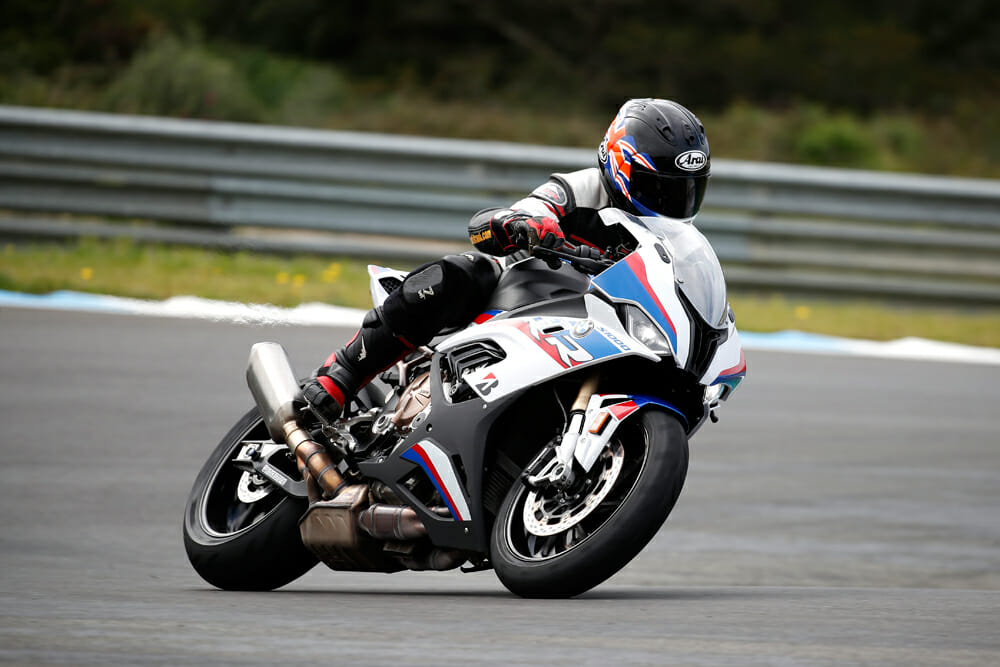
This greater sense of being at one with the bike definitely made it more confidence inspiring out on the track, and in that sense, the wet conditions I had to grapple with were a good test of the new BMW’s handling. The fully adjustable electronically damped closed-cartridge 45mm Marzocchi USD fork offering 4.7 inches of wheel travel is set at a 23.1º rake with 3.7 inches of trail. Despite that quite aggressive geometry, it proved really stable at speeds up to the 171 mph I saw on the new 6.5-inch TFT dash’s digital speedo. (It has a choice of four different screens). After clicking down through the gears from top to second without touching the clutch lever thanks to BMW’s really well set up Shift Assistant Pro power shifter system that’s included as standard complete with an auto-blipper for clutchless downshifts, I got good feedback from the front Bridgestone as I leaned into the Turn 1 right-hander. Initially gingerly, then with growing confidence as I realized how grippy the front rain tire was, and how well damped the Marzocchi fork is with the new-generation DDC/Dynamic Damping Control. The Continental ABS did kick in nice and predictably in the rain, too. Made me feel like a hero—even if I wasn’t riding like one, just content to take full advantage in the drenched conditions of the fabulous array of electronic rider aids which the new BMW brings to the party. And the quite high level of engine braking left dialed into the Rain riding mode, and slipper clutch settings helped support the Hayes/Brembo/Nissin front brake cocktail in slowing the bike from high speed.
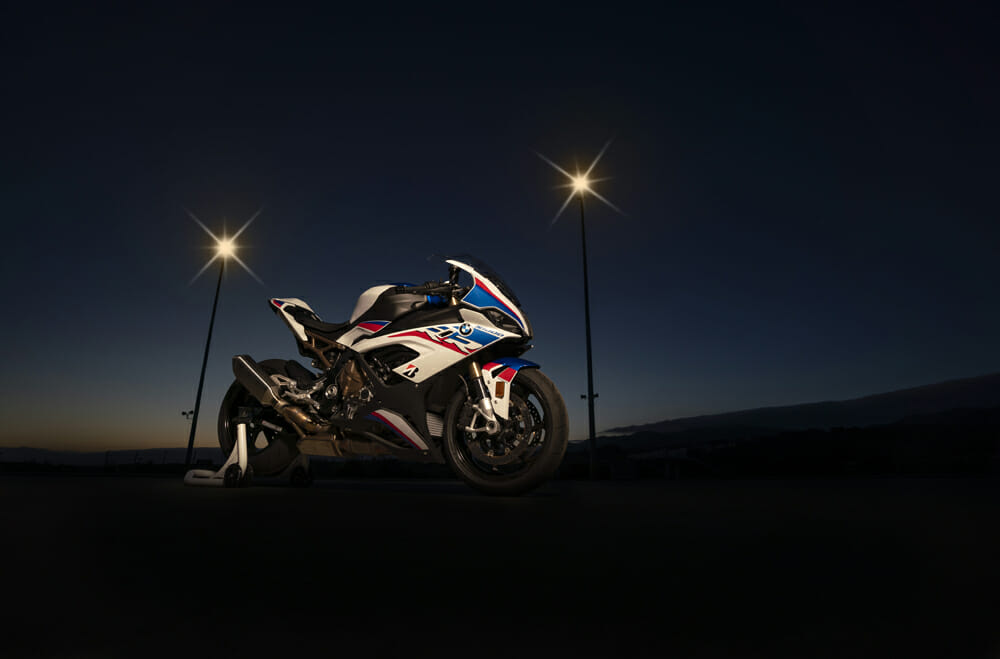
But the qualities of that wonderful new engine shone through in the downpour, especially in the first session before it started raining hard again when I found a few sections that I knew were dry where I could use Road and even Dynamic riding modes on. It picks up engine speed noticeably faster than the older bike, which wasn’t exactly a sluggard, but still had more internal inertia to overcome under acceleration. But BMW’s engineers have controlled this extra zest very well. Not only is the extra zip in throttle response decidedly user-friendly rather than intimidating, but it’s also a factor in the way the new bike is so easy-steering, with a reduced gyroscopic effect on the handling—and that’s further magnified by the carbon wheels fitted to the M-bike I was riding. Yet it’s also very flexible, pulling seamlessly from as low as 4000 rpm upwards all the way to the rev-limiter, with no steps in the power delivery—not even when the variable intake system sees the air-scoops lift off the throttle bodies. Knowing when this would happen, I was looking out for it but couldn’t spot it, and the same for the milliseconds of transition for the SlideCam system—all entirely undetectable. It just works! And the so-called “electronic throttle grip,” an electromotive throttle actuator, delivers a pleasant reduction in the force required to operate the throttle butterflies, while at the same time providing full controllability of the engine, especially in the damp conditions.
The new BMW’s acceleration is genuinely awe-inspiring. I can’t say, however, that I experienced how well it hooks up the rear tire out of turns in the dry, beyond noting that the Rain mode’s TC/traction control settings worked very well. This was verified by the way the orange light on the dashboard flickered for about 90% of a damp Estoril lap, including at high speed down the main straight! I’ll just have to ask nicely and try to get another ride this summer on what is very definitely a significant step forward in superbike design. Its electronics programs seem readily accessible and quite user-friendly. There are lots of neat parts on this series production superbike, like the one-piece cast aluminum swingarm, or the heel guards on the footrests made from recycled carbon fiber (they should be green, not black!), that carefully shaped tank welded up in BMW’s Berlin factory, and much else. And when no less an authority than the fastest man ever round the Isle of Man’s TT Course (on a BMW, naturally) Peter Hickman says this new bike is a significant step forward from the old one, you have to believe it is. CN
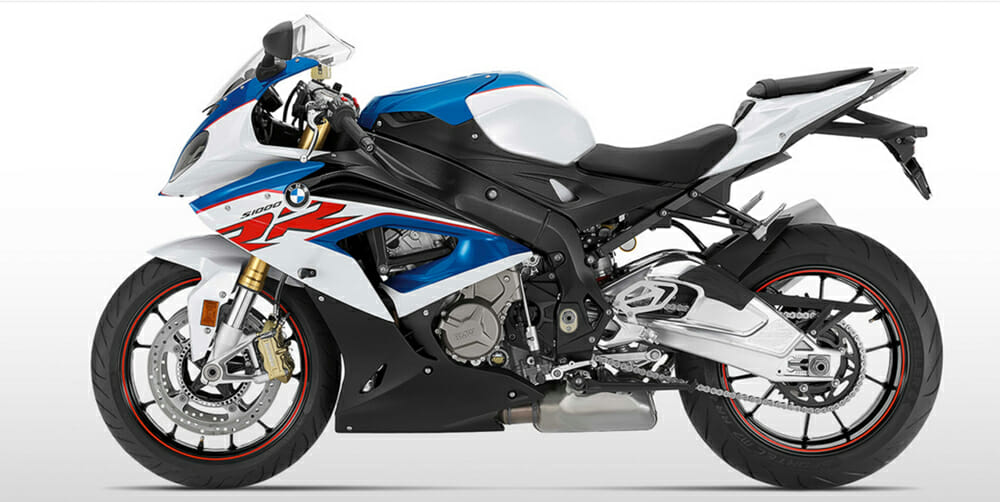
2019 BMW S 1000 RR Specifications
| MSRP | $20,000 standard / $25,000 M Package |
| ENGINE: | Water-cooled, 4-stroke, in-line, 4 cylinder |
| VALVE DRIVE: | DOHC, 4-valves-per-cylinder, valve activation via individual rocker arms and variable intake camshaft control system BMW ShiftCam |
| DISPLACEMENT: | 999cc |
| BORE / STROKE: | 80mm / 49.7mm |
| OUTPUT: | 152kW/207hp @13,500 rpm |
| TORQUE: | 113Nm @ 10,500 rpm |
| THROTTLE VALVE DIAMETER: | 48mm |
| ENGINE CONTROL: | BMS-O |
| EMISSION CONTROL: | Closed-loop three-way catalytic converter |
| TRANSMISSION: | 6-speed, constant mesh |
| CLUTCH: | Self-reinforcing multi-plate anti-hopping wet clutch |
| REAR WHEEL DRIVE: | Chain |
| FRONT SUSPENSION: | USD telescopic fork, 45mm, fully adjustable, DDC option: damping electronically adjustable |
| REAR SUSPENSION: | Aluminum underslung double-sided swingarm w/central spring strut, fully adjustable; DDC option: damping electronically adjustable |
| FRONT WHEEL TRAVEL: | 4.7 in. |
| REAR WHEEL TRAVEL: | 4.6 in. |
| FRONT BRAKE: | Twin 320mm disc, floating, radial 4-piston fixed calipers; BMW Motorrad ABS Pro |
| REAR BRAKE: | Single 220mm disc, 1-piston floating caliper; BMW Motorrad ABS Pro |
| TRACTION CONTROL: | BMW Motorrad DTC |
| WHEELS: | Die-cast aluminum wheels, carbon fiber M Package option |
| FRONT WHEEL: | 3.50 x 17 in. |
| REAR WHEEL: | 6.00 x 17 in. |
| FRONT TIRE: | 120/70 ZR17 |
| REAR TIRE: | 190/55 ZR17 |
| WHEELBASE: | 56.7 in. |
| SEAT HEIGHT: | 32.4 in. |
| WEIGHT (wet, claimed): | 434.3 lbs. (standard) / 430.8 lbs. w/Race Package option / 427.6 lbs. w/M Package option |
| FUEL CAPACITY: | 4.4 gal. |
Click here to read the 2019 BMW S 1000 RR First Review in the Cycle News Digital Edition Magazine.
Click here for more BMW motorcycle reviews and news.
Click here for the latest Cycle News Sportbike motorcycle reviews and news.
